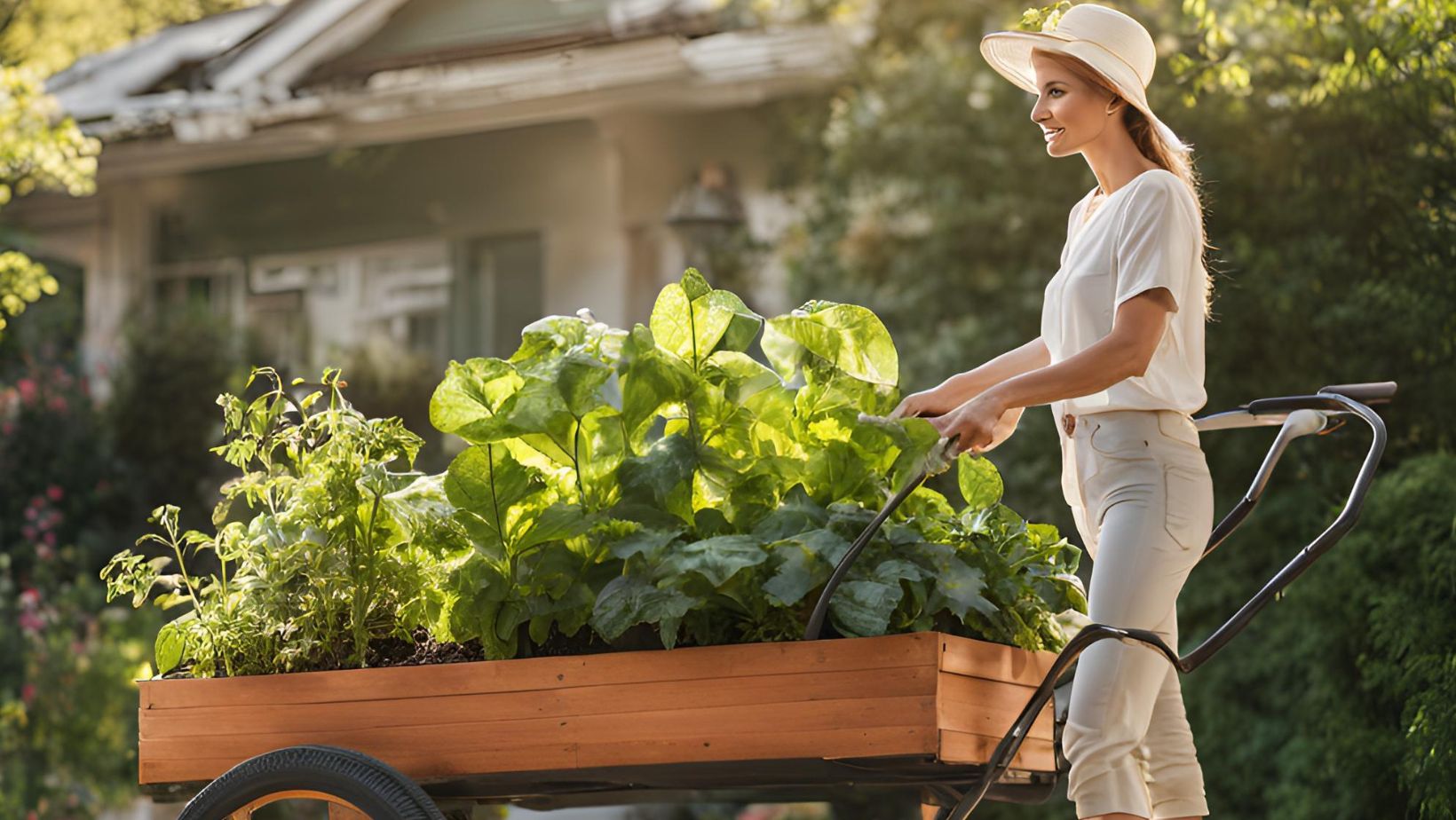
I’ve spent countless hours in my garden hauling tools supplies and harvested vegetables which taught me the incredible value of a reliable gardening wagon. It’s amazing how this simple yet essential tool has transformed my gardening experience from a back-breaking chore into an efficient and enjoyable activity.
Whether you’re a seasoned gardener or just starting your green journey a gardening wagon is more than just a convenience – it’s a game-changer. I’ll help you understand why investing in the right wagon can make all the difference in maintaining your outdoor paradise while saving time and protecting your back from strain. From heavy-duty metal carts to collapsible fabric models there’s a perfect wagon for every gardening style and budget.
Key Takeaways
- A gardening wagon is a crucial tool that can significantly reduce physical strain and save time, offering weight capacities from 150 to 1,200 pounds for various gardening tasks
- Three main types of gardening wagons exist: heavy-duty garden carts (800-1,200 lbs capacity), collapsible utility wagons (150-300 lbs), and traditional wheelbarrows (300-400 lbs)
- Essential features to look for include large pneumatic tires (10-13 inches), 360-degree turning radius, weather-resistant materials, and appropriate weight capacity for your needs
- Proper maintenance, including regular cleaning, wheel care, rust prevention, and hardware inspection, can significantly extend your wagon’s lifespan
- Most gardeners save 3-4 hours weekly using a garden wagon, with physical strain reduction of 65-80% across various gardening tasks
Gardening Wagon
A gardening wagon is a four-wheeled cart designed for transporting gardening materials, tools, plants, soil bags & harvested crops. I’ve found these specialized carts come with deep baskets, sturdy frames & rugged wheels to handle outdoor terrain.
Key features of a gardening wagon include:
- Pull handles for easy maneuvering
- Large pneumatic tires for rough ground navigation
- Removable sides for oversized loads
- Weight capacities ranging from 150-1200 pounds
- Weather-resistant materials like powder-coated steel
Here’s how a gardening wagon enhances productivity:
| Task Type | Time Saved (Per Week) | Physical Strain Reduction |
|---|---|---|
| Tool Transport | 45 minutes | 65% less lifting |
| Soil Moving | 90 minutes | 80% less back strain |
| Harvest Collection | 60 minutes | 70% less bending |
I rely on my gardening wagon for these essential tasks:
- Moving multiple bags of mulch, soil & fertilizer
- Transporting long-handled tools like rakes & shovels
- Collecting weeds, branches & yard debris
- Hauling watering cans & hoses between garden zones
- Carrying seedlings & potted plants
Specific applications that demonstrate the wagon’s versatility:
- Loading 6-8 bags of topsoil simultaneously
- Organizing 12+ gardening tools in one trip
- Collecting 5 bushels of vegetables during harvest
- Moving 4-5 potted shrubs at once
- Hauling 200 pounds of rocks for landscaping
- Reduced back strain from heavy lifting
- Minimized repeated trips across the garden
- Decreased physical fatigue during long tasks
- Enhanced stability when moving unstable loads
- Lower risk of muscle injuries from overexertion
Types of Gardening Wagons
From my extensive gardening experience, I’ve identified three primary categories of gardening wagons, each serving distinct purposes in the garden. These options accommodate different needs, from heavy-duty hauling to lightweight transportation.
Heavy-Duty Garden Carts
Heavy-duty garden carts feature sturdy metal or poly construction with weight capacities ranging from 800 to 1200 pounds. I’ve found these carts excel with their pneumatic tires measuring 15-20 inches, steel mesh beds extending 4-6 feet long, removable side panels for oversized loads. The dump feature tilts loads up to 60 degrees for easy unloading of mulch, soil bags, rocks.
Collapsible Utility Wagons
Collapsible utility wagons combine portability with 150-300 pound capacity in a lightweight fabric design. These wagons fold to 8 inches thick for storage, expand to 3.5 cubic feet of cargo space, include 4 cup holders, mesh pockets for tools. The 7-inch wheels navigate paved paths while the telescoping handle extends to 32 inches for comfortable pulling.
Traditional Wheelbarrows
Traditional wheelbarrows provide focused maneuverability with their single wheel design, 4-6 cubic foot steel or poly tubs, 300-400 pound capacities. I rely on their 16-inch pneumatic tires for precise control, wood handles for leverage, steep dump angles up to 75 degrees. The narrow profile measures 30 inches wide to access tight garden spaces between beds.
| Wagon Type | Weight Capacity | Tire Size | Cargo Space |
|---|---|---|---|
| Heavy-Duty | 800-1200 lbs | 15-20″” | 4-6 ft long |
| Collapsible | 150-300 lbs | 7″” | 3.5 cu ft |
| Wheelbarrow | 300-400 lbs | 16″” | 4-6 cu ft |
Key Features to Look for in a Gardening Wagon
Based on my extensive gardening experience, I’ve identified several critical features that determine a gardening wagon’s functionality and durability. These features significantly impact the wagon’s performance across different gardening tasks and terrain types.
Weight Capacity and Size
The ideal gardening wagon accommodates loads between 300-1200 pounds, depending on its primary use. I recommend measuring your storage space first, as wagons range from compact 36×20-inch models to larger 48×24-inch options. A deep bed depth of 12-16 inches proves essential for bulky items like mulch bags compost. Here’s a breakdown of common capacity ranges:
| Wagon Type | Weight Capacity | Typical Dimensions |
|---|---|---|
| Light-Duty | 150-300 lbs | 36″”x20″”x12″” |
| Medium-Duty | 300-800 lbs | 42″”x22″”x14″” |
| Heavy-Duty | 800-1200 lbs | 48″”x24″”x16″” |
Wheel Design and Maneuverability
Large pneumatic tires measuring 10-13 inches provide optimal performance on uneven terrain. I’ve found that wagons with a turning radius of 360 degrees offer superior maneuverability in tight spaces. Key wheel features include:
- All-terrain tires with deep treads for enhanced traction
- Wide wheel base for improved stability on slopes
- Ball-bearing construction for smooth rolling
- Rust-resistant wheel hubs for longevity
- Heavy-gauge steel mesh beds for proper drainage
- UV-resistant poly bed liners to prevent material degradation
- Reinforced corner joints for structural integrity
- Weatherproof hardware including stainless steel nuts bolts
- Impact-resistant poly wheels with sealed bearings
Top Uses for Your Garden Wagon
A gardening wagon transforms multiple outdoor tasks into efficient single-trip operations. Here’s how I maximize my wagon’s utility in different gardening scenarios.
Hauling Tools and Supplies
My gardening wagon serves as a mobile workstation for transporting essential gardening equipment. I load it with:
- Hand tools: trowels, pruners, garden forks, weeders
- Power equipment: battery-operated trimmers, leaf blowers
- Garden supplies: fertilizers, mulch bags, pest control products
- Watering equipment: hoses, spray nozzles, watering cans
- Safety gear: gloves, knee pads, sun protection items
The wagon’s compartments keep tools organized while its sturdy construction handles heavy supplies like:
| Material Type | Typical Load Weight |
|---|---|
| Mulch Bags | 40-50 lbs each |
| Soil Bags | 30-40 lbs each |
| Fertilizer | 20-25 lbs each |
| Tool Set | 15-20 lbs total |
Harvesting and Plant Transport
The wagon’s design excels at protecting delicate plants during transportation. Here’s how I utilize it:
- Moving seedlings: carries 6-8 nursery flats simultaneously
- Harvesting produce: collects vegetables from multiple garden beds
- Relocating plants: transports 4-5 mature potted plants
- Flower collection: holds harvest baskets for cut flowers
- Composting: hauls yard waste to compost bins
| Produce Type | Wagon Load Capacity |
|---|---|
| Tomatoes | 40-50 lbs |
| Root Vegetables | 60-70 lbs |
| Leafy Greens | 20-25 lbs |
| Cut Flowers | 15-20 bouquets |
Maintenance Tips to Extend Your Wagon’s Life
Regular Cleaning
I clean my gardening wagon after each use to prevent rust formation. Removing dirt debris grass clippings prevents material buildup in moving parts. A garden hose spray removes loose debris while a stiff brush tackles stubborn dirt. I dry the wagon thoroughly with a clean cloth to prevent moisture accumulation.
Wheel Care
The wheels require specific maintenance for optimal performance:
- Inspect tire pressure monthly maintaining 20-30 PSI for pneumatic tires
- Lubricate wheel bearings every 3 months using silicone-based lubricant
- Check wheel alignment ensuring straight tracking
- Remove embedded stones twigs from tire treads after use
Rust Prevention
I protect metal components through these proven methods:
- Store the wagon in a covered dry area
- Apply protective coating annually using rust-resistant paint
- Touch up paint chips immediately with matching outdoor paint
- Install rubber matting in the bed to minimize metal exposure
Hardware Inspection
Monthly hardware checks maintain structural integrity:
- Tighten loose nuts bolts using appropriate wrenches
- Replace damaged fasteners with stainless steel alternatives
- Check weld points for signs of separation
- Verify handle connections remain secure
- Park on level ground to prevent frame stress
- Cover with weatherproof tarp during extended non-use
- Empty contents after each use
- Store upright avoiding prolonged side storage
| Maintenance Task | Frequency | Tools Required |
|---|---|---|
| Basic Cleaning | After each use | Hose brush cloth |
| Tire Pressure Check | Monthly | Tire gauge pump |
| Lubrication | Every 3 months | Silicone lubricant |
| Hardware Inspection | Monthly | Wrench set |
| Rust Treatment | Annually | Paint brush coating |
A Game-Changer for Any Garden Enthusiast
A gardening wagon isn’t just another tool – it’s a game-changer for any garden enthusiast. Through my years of experience I’ve seen how this versatile companion can transform tedious gardening tasks into efficient and enjoyable activities.
Whether you choose a heavy-duty cart collapsible wagon or traditional wheelbarrow the right gardening wagon will become an indispensable part of your outdoor routine. With proper maintenance and care it’ll serve you faithfully for years to come.
I’m confident that investing in a quality gardening wagon is one of the smartest decisions you can make for your gardening journey. It’s time to say goodbye to multiple trips and backaches and hello to more productive and enjoyable gardening sessions.





